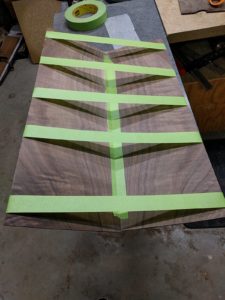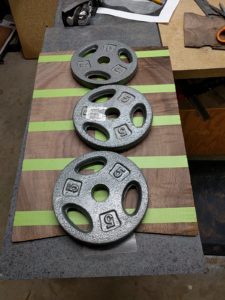When bookmatching tops and backs, one has to (of course) glue together two fairly thin pieces of wood. (They are taken down to the final thickness after being glued together.) During the gluing process one has to clamp the two halves together (again, of course). I have tried various ways of doing the clamping, made some gluing/clamping boards with threaded pressure things on the side, made a board to use the old ‘rope’ & wedges way of joining halves, etc. I don’t remember where I saw it, but my current technique, which works very well, particularly for plate halves which do not have parallel outer edges, is simplicity in itself. All it takes is tape, a flat surface, and a couple of heavy things.
To start with, the flat surface. I use a chunk of Corian counter top. Counter top material, (granite, quartz, Corian) can be had real cheap from any countertop fabricator. Things like sink cut-outs make great absolutely flat surfaces in the workshop and are a waste product of the fabricator. I have a number. Anyway, I first lay down a strip of wax paper.
Then one bookmatches the halves together, looking at the ‘show’ side that will be seen, sliding them along each other slightly to get the best possible match. When you get the right position, tape the halves together to hold the position with a small piece of tape. Then turn the package over (you are now looking at what will the the inside or ‘hidden’ side) and put a long piece of tape along the seam to make a hinge. Remove the small piece of tape from the show side. Then hinge the sides up into a ‘V’ and place tape across and over the edges. The tape I use is Scotch 233+ which has a fair amount of stretch. The stretch-ability is important. Place tape across the ‘V’ every couple of in inches.
Then flip the package over, apply glue along the edges (the tape hinge holds the glue in the seam) and then press the package, still in a ‘V’, down on the strip of wax paper to make sure the edges of what will be the ‘show’ side are down and flat and even. Then gently bend the ‘V’ down flat, stretching the tape. When it goes flat there will be very little force springing it back up into a ‘V’ since the stretch force is now directly almost perfectly horizontally. It is overkill but I use a couple of handy barbell weights to keep things down as the glue dries. The tension of the tape stretch is quite strong, without being so much that the glue joint gets ‘starved’ of glue from too much pressure.
Let the glue dry, strip off the tape and wax paper, and you are done.


